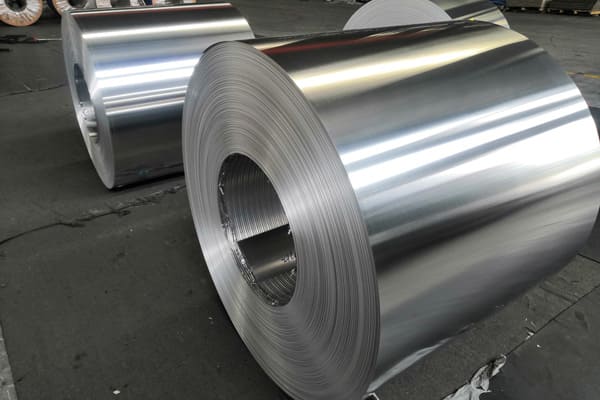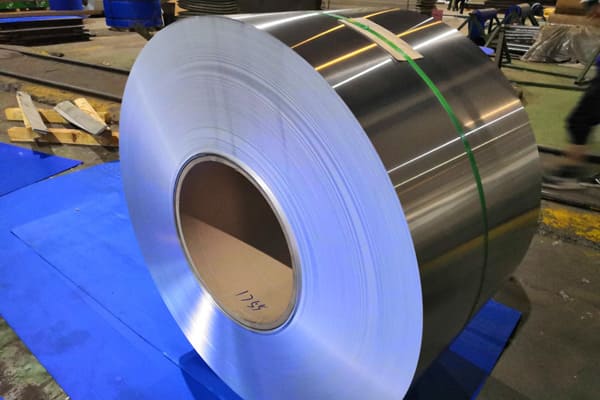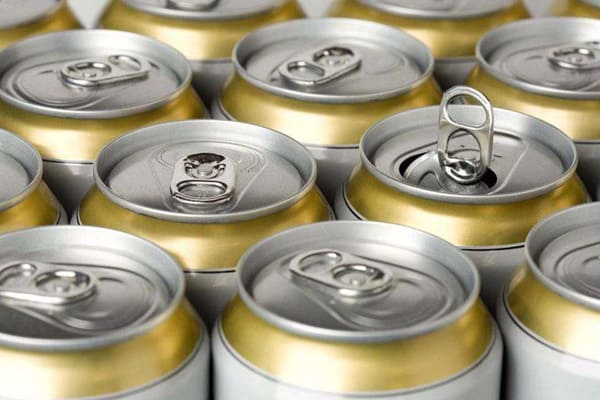In our daily life, we see many cans, such as beer cans, plechovky od nápojů, food cans, atd., so what materials are these cans made of? What are their differences?
There are two types of jar materials we have seen:

3104 h18 aluminum coil for cans
The alloy types generally used in the production of aluminum cans are 3104 slitina, 3105 slitina, 5052 slitina, 5182 slitina, atd.;
Metal cans are divided into two-piece cans and three-piece cans according to their structure;
The three-piece can is composed of three parts: the can body, the can bottom and the can lid;

Tinplate Cans (three-piece)
The two-piece can is composed of two parts: the can lid and the integral seamless can body with the bottom, and the can body and the can lid are crimped;

Aluminum Cans(two-piece)
When aluminum is used as material, it is mainly made into two-piece cans, and when tinplate is used as material, it is mainly made into three-piece cans. The difference between the two is mainly the manufacturing process of the can body.
More information:Hliníkový plech/cívka na plechovky
3104/3105/5052/5182 představují různé třídy slitin hliníku. 3104, 3105, 5052, a 5182 jsou čtyři běžné materiály pro výrobu plechovek. They have some differences in chemical composition and physical properties, but they can meet the different requirements of customers;

3104 h18 aluminum coil
| Slitina | A | Fe | Cu | Mn | Mg | Cr | Zn | Z | Ostatní | Al: Min. |
| 3104 | 0.60 | 0.80 | 0.05~0.25 | 0.8~1.4 | 0.8~1.3 | – | 0.8~1.3 | – | 0.15 | zbytek |
| 3105 | 0.60 | 0.70 | 0.30 | 0.3~0,8 | 0.2~0,8 | 0.20 | 0.40 | 0.10 | 0.15 | zbytek |
| 5052 | 0.25 | 0.40 | 0.10 | 0.10 | 2.2~2.8 | 0.15~0,35 | 0.10 | – | 0.15 | zbytek |
| 5182 | 0.20 | 0.35 | 0.15 | 0.2-0.5 | 4.0-5.0 | 0.10 | 0.25 | – | 0.15 | zbytek |
| Slitina | 3104,3105,5042,5052,5182 |
| Nálada | H18,H19,H48 |
| Tloušťka | 0.2-0.35mm(commen 0.270mm,0.280mm) |
| Tolerance tloušťky | ±0.005mm |
| Šířka | 800-1730mm(commen 1600mm,1700mm) |
| aplikace | 3104/3105 H18/H19 for cans body,3104/5052/5182 H48 for cans lid |
| 1.Reducing the blank The cutting-edge approach for making aluminum beverage cans is called two-piece drawing and wall ironing. The technique starts with an aluminum ingot which changed into cast to be approximately 30 palce (seventy six cm) tlustý, then rolled into a skinny sheet. The first step inside the actual manufacture of the can is to cut the sheet into a circle, known as a clean, in order to form the lowest and sides of the can. Each blank is five.Five inches (14 cm) in diameter. Some material is always The small ripples on the pinnacle of the metallic are called “ears”. “Earing” is an unavoidable effect of the crystalline structure of the aluminum sheet. The small ripples on the pinnacle of the metallic are known as “ears”. “Earing” is an unavoidable impact of the crystalline structure of the aluminum sheet. Lost between every circle, but manufacturers have discovered that minimum aluminum is lost whilst the sheets are huge enough to maintain two staggered rows of 7 blanks each. O 12-14% of the sheet is wasted, but may be reused as scrap. After the round clean is cut, it’s miles “drawn” or pulled up to form a cup three.Five inches (8.Nine cm) in diameter. |
 |
| 2.Redrawing the cup The small cup as a result of the initial draw is then transferred to a 2nd device. A sleeve holds the cup exactly in location, and a punch diminished rapidly into the cup redraws it to a diameter of approximately 2.6 palce (6.6 cm). The peak of the cup will increase simultaneously from the preliminary 1.3 to two.25 inches (three.Three to 5.7 cm). The punch then pushes the cup in opposition to three jewelry called ironing jewelry, which stretch and skinny the cup walls. This whole operation—the drawing and ironing—is done in a single non-stop punch stroke, which takes handiest one fifth of a 2d to complete. The cup is now about 5 palce (13 cm) excessive. Then any other punch presses up in opposition to the base of the cup, causing the lowest to bulge inward. This form counteracts the pressure of the carbonated liquid the can will incorporate. The bottom and lower walls of the can also are a bit thicker than the top partitions, for added power. |
 |
| 3.Trimming the ears The drawing and ironing process leaves the can slightly wavy on the pinnacle. These small ripples inside the metallic are known as “ears.” “Earing” is an unavoidable impact of the crystalline shape of the aluminum sheet. Aluminum agencies have studied this phenomenon drastically, and they had been capable to steer the position and peak of the ears with the aid of controlling the rolling of the aluminum sheet. Despite the fact that, some material is lost at this stage. Approximately a quarter inch is trimmed from the top of the can, leaving the higher walls immediately and stage. |
 |
| 4.Cleaning and decorating The drawing and ironing process leaves the outer wall of the can with a clean, shiny surface, so it does no longer require any in addition finishing inclusive of polishing. After the ears are trimmed, the can is cleaned and then imprinted with its label. After the can is adorned, it’s far squeezed in barely at the top to a make a neck, and the neck is given an out-ward flange at the very pinnacle facet, on the way to be folded over once the lid is introduced. |
 |
| 5.The lid The lid is made of a slightly exceptional alloy than the aluminum for the bottom and facets of the can. The inward bulge of the bottom of the can facilitates it withstand the pressure exerted by the liquid inner it, however the flat lid have to be stiffer and more potent than the base, so it is fabricated from aluminum with extra magnesium and less manganese than the rest of the can. This effects in more potent steel, and the lid is significantly thicker than the walls. The lid is cut to a diameter of 2.1 palce (5.Three cm), smaller than the two.6-inch (6.6 cm) diameter of the partitions. The middle of the lid is stretched upward barely and drawn through a system to shape a rivet. The pull tab, a separate piece of metallic, is inserted underneath the rivet and secured by way of it. Then the lid is scored so that when the tab is pulled by using the purchaser, the metal will detach without problems and depart the right beginning. To make certain that the cans are made nicely, they’re routinely checked for cracks and pinholes. One in 50,000 cans is typically found to be faulty. |
 |
| 6.Filling and seaming After the neck is formed, the can is prepared to be crammed. The can is held tightly against the seat of a filling system and a beverage is poured in. The lid is added. The top flange fashioned whilst the can become given its neck is then bent around the lid and seamed shut. At this point, the can is ready on the market. |
 |
resours:http://www.madehow.com/Volume-2/Aluminum-Beverage-Can.html
Tloušťka: The aluminum alloy 5052 hliníková cívka used for the can lid is flat, and the thickness control is more precise, and the thickness tolerance of ±0.005mm can be guaranteed to ensure the stability of the later processing.
Plochost: the strip does not allow obvious waves, the wave height within 1 meter does not exceed 3mm, and the wave does not exceed 3/m;
Side curvature: the side curvature of the product on any 2000mm length should not be greater than 0.5mm;
Terminal warpage: any product with a length of 1500mm is cut, and the height of the terminal warpage is ≤5mm;
Klouby: No joints are allowed.
Povrch: Severe air bubbles, paint leaks, škrábance, koroze, olejové skvrny, odlupování, streaks, color differences, mottled spots, rolovací značky, periodicity, atd. are not allowed to affect the appearance quality of the product, and the burrs are <=0.04mm;
End face: the end face is neat, tight without loose layer, staggered layer ≤ 2mm, tower shape ≤ 5mm;
v 1940, Europe and the United States began to sell beer in stainless steel cans. Ve stejnou dobu, the appearance of aluminum cans also became a leap in canning technology. v 1963, the can was invented in the United States. It inherited the shape and design characteristics of the previous cans, and a pop-top was designed on the top.
This is a revolution in the way of opening, which has brought great convenience and enjoyment to people, so it will be widely used soon. By 1980, the European and American markets basically adopted this aluminum can as the packaging form of beer and carbonated drinks. With the advancement of design and production technology, aluminum cans tend to be lightweight, from the initial 60 grams to about 21 na 15 grams in 1970.
Manufacturing techniques for aluminum soda cans have continued to improve over the decades. The weight of aluminum cans has been greatly reduced. In the early 1960s, the weight of every thousand aluminum cans (including cans and lids) reached 55 liber (o 25 kilograms), and in the mid-1970s it dropped to 44.8 liber (25 kilograms). kilogram), which was reduced to 33 liber (15 kilograms) in the late 1990s, and has now been reduced to less than 30 liber, which is nearly half that of 40 years ago.

aluminum cans history
In the 20 years from 1975 na 1995, the number of aluminum cans (kapacita 12 unce) made of 1 pound of aluminum increased by 35%. According to the statistics of the American ALCOA company, the aluminum required for every thousand aluminum cans decreased from 25.8 pounds in 1988 na 22.5 pounds in 1998 a 22.3 pounds in 2000.
American can manufacturers have continuously made breakthroughs in sealing machinery and other technologies, so the thickness of aluminum cans in the United States has dropped significantly, z 0.343 mm in 1984 na 0.285 mm in 1992 a 0.259 mm in 1998.
Silná hliníková fólie poskytuje extra pevnost a odolnost proti roztržení. Mnoho kuchařů ho používá k pečení, grilování, a skladování. Většina rolí fólie zn "těžké povinnosti" jsou mezi 0.0008" a 0.001" tlustý, což je zhruba 0,02032-0,0254 mm v národních jednotkách
Farmaceutická fólie, také známá jako fólie lékařské kvality nebo fólie na puchýře, 8011,8021,8079 hliníková fólie běžně používaná pro farmaceutické obalové fólie.
Kabelová hliníková fólie, také známý jako hliníková fólie pro kabel, označuje specifický typ hliníkové fólie, která se používá při výrobě kabelů a vodičů.
Huawei Aluminium je vaším spolehlivým partnerem 1070 Výrobky z hliníkové cívky. S naším závazkem ke kvalitě, přizpůsobení, a konkurenceschopné ceny, snažíme se splnit a překonat vaše očekávání.
6082 hliníkový pás může být obvykle tepelně zpracován pro vyšší pevnost, ale relativně nízká tažnost.6082 hliníková slitina je jedním ze slitinových modelů...
1050 Hliníková cívka patří mezi komerčně čisté tepané 1000 série slitin s čistotou 99.5% hliník. Tato slitina se obvykle používá pro válcování za studena nebo vytlačování. Má vlastnosti vysoké plasticity, odolnost proti korozi, elektrická vodivost, a tepelnou vodivostí.
č.52, Dongming Road, Zhengzhou, Henan, Čína
Henan Huawei Aluminium Co., Ltd, Jeden z největších dodavatelů hliníku v Číně Henan,Jsme založena v roce 2001 a máme bohaté zkušenosti s dovozem a vývozem a vysoce kvalitními hliníkovými výrobky
Po – So, 8AM – 17:00
Neděle: ZAVŘENO
© Copyright © 2023 Henan Huawei Aluminium Co., Ltd
Nejnovější komentáře
Vážený pane, Please offer your best FOB Prices specs are as under ALUMINIUM STRIP (AL=99,50 % MIN) VELIKOST:450 X32 X6 MM. VAŠE 570 EN-AW 1050 A, MNOŽSTVÍ=3400KG
Ahoj, Byl byste tak laskav a nabídl následující zboží: Cívka 0,6x1250 (1000)mm EN AW-3105 5tons
Ahoj, Můžete mi nabídnout hliníkové desky? Vlastně potřebuji: 110mm x 1700 mm x 1700 mm 5083 H111 - 21 pcs Next year planed is 177 ks
Skvělý článek. byl jsem potěšen, že jsem našel tento článek. Mnoho lidí si to myslí, že mají spolehlivé znalosti o tomto tématu, ale často tomu tak není. Proto mé příjemné překvapení. Jsem ohromen. Určitě doporučím toto místo a vrátím se častěji, vidět nové věci.
požadavek na hliníkový pásek